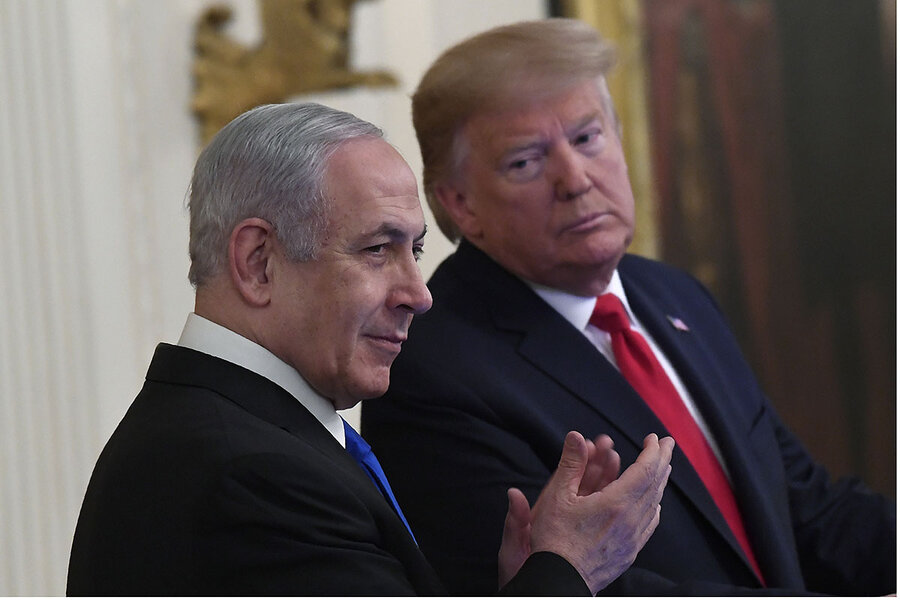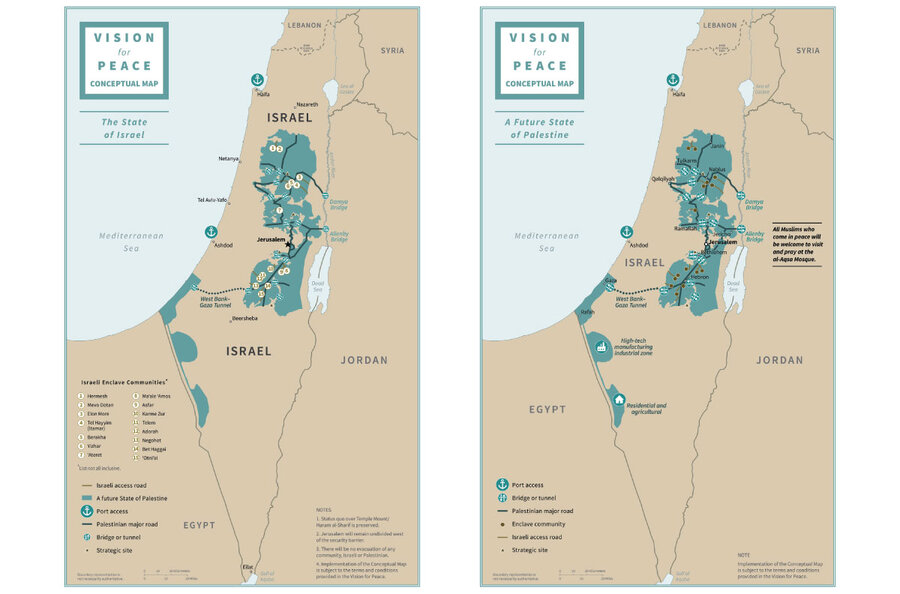Trump’s Mideast ‘Deal’: Four questions on who gets what
Loading...
| Tel Aviv, Israel
Israeli Prime Minister Benjamin Netanyahu was there. Palestinian President Mahmoud Abbas was not. As President Donald Trump unveiled his long-awaited “Deal of the Century” Middle East peace plan, hailing it as a “win-win opportunity,” the optics alone were a problem.
President Trump’s vision for peace tips heavily to the side of Israel’s historic negotiating positions regarding borders, Jerusalem, Jewish settlements, Palestinian refugees, and limits on the sovereignty of a Palestinian state. Mr. Netanyahu declared the plan a “historic recognition” of Israeli sovereignty over portions of the West Bank “vital” to its security and central to Jewish heritage.
Why We Wrote This
President Trump came into office promising to succeed where so many had failed in formulating a plan for peace between Israelis and Palestinians. After three years, we get a look at his vision.
Saying he has “done a lot” for Israel, Mr. Trump said he is obliged to do the same for the Palestinians or “it just wouldn’t be fair.” Yet his plan makes Palestinian statehood contingent on a list of prerequisites, including the disarming of Hamas in the Gaza Strip and changes in Palestinian textbooks. Mr. Abbas responded to President Trump by saying “your conspiracy plan won’t pass.”
The plan has triggered momentum in Mr. Netanyahu’s government to immediately annex portions of the West Bank. For specific provisions of the plan, which faces legal and political hurdles, please read the full version of this story.
When President Donald Trump unveiled his Israeli-Palestinian peace plan Tuesday, a two-state initiative that was three years in the making, he hailed it as a “win-win opportunity” that will ensure prosperity and a brighter future for the region.
But the optics of the event – with Israel’s leader present and his Palestinian counterpart absent – and the plan’s provisions suggest it faces significant political and legal hurdles.
Mr. Trump’s vision for peace tips heavily to the side of Israel’s historic negotiating positions regarding borders, Jerusalem, Jewish settlements, Palestinian refugees, and limits on the sovereignty of a Palestinian state.
Why We Wrote This
President Trump came into office promising to succeed where so many had failed in formulating a plan for peace between Israelis and Palestinians. After three years, we get a look at his vision.
Saying he has “done a lot” for Israel, Mr. Trump said he is obliged to do the same for the Palestinians or “it just wouldn’t be fair.” Yet his plan makes Palestinian statehood contingent on a substantial list of prerequisites, including the disarming of Hamas and other armed groups in the Gaza Strip.
Israeli Prime Minister Benjamin Netanyahu declared the plan a “historic recognition” of Israeli sovereignty over portions of the West Bank “vital” to its security and central to Jewish heritage.
Palestinian President Mahmoud Abbas responded to President Trump by saying “your conspiracy plan won’t pass.”
The peace initiative stretches over 53 pages with 22 sections and two annexes. It includes a map showing a jigsaw puzzle Palestinian state in the West Bank and Gaza linked by hair-thin corridors.
A companion 128-page economic plan details a 10-year development plan for the Palestinians, promising tens of billions of dollars in investment and a boom in prosperity.
Here are four questions about the plan:
What does it offer Israel?
The Trump administration vision incorporates territory in the Jordan Valley as well as settlements in the West Bank where 97% of Jewish settlers reside. The remainder would live in Israeli-controlled enclaves within the Palestinian state. The Israeli military would retain control throughout the West Bank even after a Palestinian state is established.
In Jerusalem, Israel would retain control over the Old City and the city’s holy sites, as well as the core Palestinian neighborhoods of East Jerusalem.
Palestinian refugees would not have a right to return to areas inside Israel, eliminating a historic demand for hundreds of thousands of Palestinians displaced in the 1948 Arab-Israeli war.
Israel and the U.S. would have sole authority to judge whether the Palestinians meet the preconditions for statehood, including eliminating inciteful content in Palestinian textbooks.
The Trump plan also encourages Arab countries to normalize ties with Israel.
What does it offer the Palestinians?
The Trump plan’s vision for Palestinian statehood reroutes the 1967 border in some places to incorporate Arab towns inside Israel and enclaves in the Negev desert along the border with Egypt.
It calls for the establishment of a land link between the West Bank and the Gaza Strip, as well as a network of highways joining pieces of the Palestinian state and linking it to the border with Jordan, via Israeli land in the Jordan Valley.
The initiative envisions a Palestinian capital – and a U.S. embassy – in the outlying neighborhoods of East Jerusalem beyond Israel’s security barrier.
A “refugee trust” fund would be set up to compensate Palestinian refugees.
The plan calls for a moratorium on Israeli settlement expansion in areas envisioned as part of a future Palestinian state; it calls for a halt in home demolitions.
Economically, the Trump initiative envisions $50 billion in investment and the creation of a million jobs over a decade, a tripling of GDP, and a 50% decline in the poverty rate. It gives Palestinians a designated area at two Israeli seaports and a tourism zone at the shore of the Dead Sea.
How does it differ from previous plans?
Though it calls for Israeli-Palestinian negotiations, the Trump plan provides a path for Israel to unilaterally annex portions of the West Bank. The Palestinians were estranged from the process that led up to the plan, owing to previous unilateral moves by the Trump administration.
It also all but ignores United Nations Security Council resolutions that have been the basis of peacemaking, saying they “have not and will not resolve the conflict.”
It rejects the principle that the Palestinians are owed territory equal to 100% of the areas of the West Bank and the Gaza Strip before 1967. That means it dispenses with the “Green Line” dividing Israel from the West Bank – the line doesn’t even appear in the plan’s maps as a basis for comparison between current and proposed partition of the territory between Israel and Palestine.
The Palestinians are given no standing in East Jerusalem or the Old City.
The plan endorses a provocative change in access to the Temple Mount/Haram al-Sharif, the Old City plaza holy to Jews and Muslims – despite saying that the “status quo” there should continue, an internal contradiction.
Under the status quo, the area has been reserved exclusively for Muslim prayer, but the Trump vision says “people of every faith” should be allowed to worship there. In the past, efforts by Israeli politicians and activists to permit Jewish prayer at the holy site have fueled violence on the mount and throughout the region.
The Trump vision marks the first time an international plan suggests that Israeli Arab towns and cities be transferred to a Palestinian state.
What is the impact of the plan?
The plan has triggered political momentum in Mr. Netanyahu’s government to immediately annex portions of the West Bank. Such a move is nonetheless legally questionable and politically precarious because of the government’s “transitional” lame duck status and because Mr. Netanyahu himself has been indicted for corruption.
Around the region, reaction is still building. The few voices of support see the plan as a starting point for negotiations, not a final deal. It has sparked calls for protest around the Palestinian territories and a security alert from the U.S. Embassy in Israel warning Americans against visiting Jerusalem’s Old City and Temple Mount.
Even Jewish settlers, political allies of Mr. Netanyahu, have rejected the plan because it envisions a Palestinian state in the West Bank.
The plan will figure prominently in Mr. Netanyahu’s reelection campaign ahead of a March 2 vote, and perhaps shift the debate away from his legal troubles. Even though Mr. Netanyahu’s rival, Benny Gantz, has endorsed the plan, critics have called it a political gift by President Trump to the prime minister.










